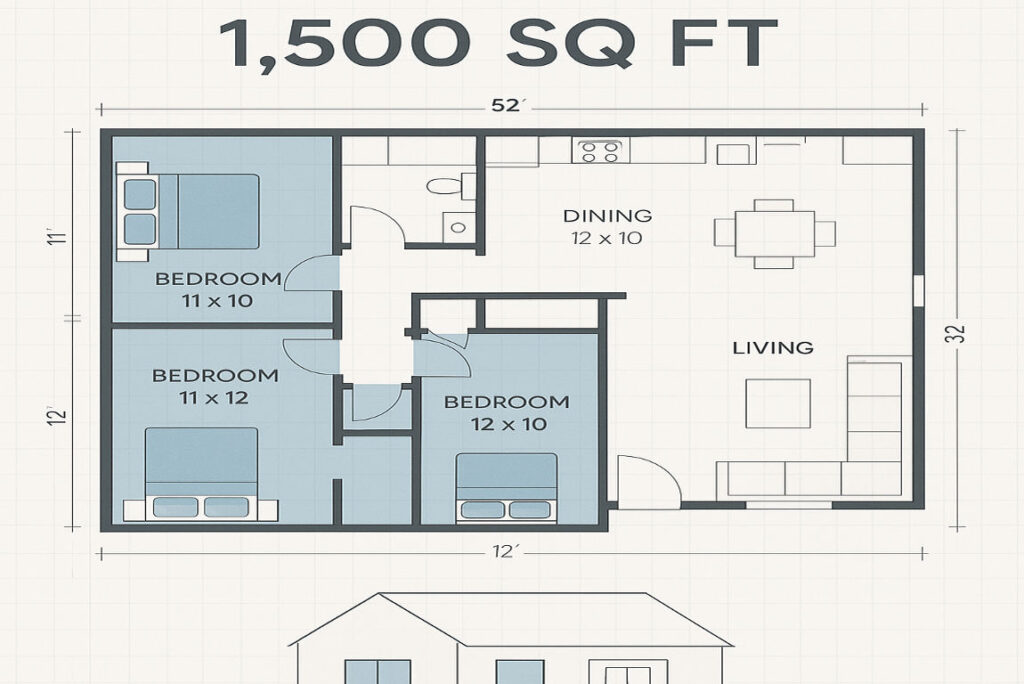When it comes to buying or building a home, one of the most important considerations is its size. For families, a three-bedroom house is often the perfect balance between space and affordability. But how much space is enough? Understanding the average square footage of a 3-bedroom house can help you make informed decisions that suit your lifestyle, budget, and future needs.
Understanding the Average Square Footage of a 3-Bedroom House

What Does “Average Square Footage” Mean?
The term “average square footage” refers to the typical size of a home, measured in square feet, that includes all livable areas. For a three-bedroom house, this size can vary significantly depending on location, design, and lifestyle preferences.
In the United States, the average square footage of a 3-bedroom house typically ranges from 1,200 to 2,000 square feet, with many homes averaging around 1,800 square feet. This range offers sufficient space for three bedrooms, a living area, a kitchen, and additional amenities such as bathrooms and storage.
Variations in Size
- Urban Homes: In cities where space is limited, three-bedroom homes are often smaller, ranging from 1,000 to 1,200 square feet. These homes maximize functionality with compact layouts.
- Suburban Homes: In suburban areas, where land is more abundant, three-bedroom homes often exceed 2,000 square feet, offering larger living spaces and additional rooms.
How Space is Allocated
In a typical three-bedroom house:
- Bedrooms account for 10-15% of the total square footage, with each bedroom averaging 100-200 square feet in size.
- Living areas, such as the living room and dining room, account for 25-30% of the total space, providing ample room for family interaction and entertaining.
- Kitchens, bathrooms, and storage spaces fill the remaining square footage, ensuring functionality and comfort.
Factors Influencing the Ideal Square Footage for a 3-Bedroom House

The “ideal” size for a three-bedroom house depends on several factors. Let’s break them down:
You may also read (elevate your space bed risers for metal frame houses).
Location and Regional Differences
- Urban Areas: Space is at a premium in cities, so homes are often smaller. Compact layouts are designed to make the most of limited square footage.
- Suburban and Rural Areas: Larger plots of land allow for more spacious homes, often exceeding the national average.
Family Size and Lifestyle Needs
- A family of four may need more space than a couple, especially if children require separate bedrooms or play areas.
- Lifestyle factors, such as working from home, may necessitate a home office, which in turn increases the necessary square footage.
Architectural Style and Layout Preferences
- Open-Concept Designs: These layouts create a sense of spaciousness, even in smaller homes, by eliminating walls between living areas, thereby enhancing the overall flow of the space.
- Traditional Layouts: These homes may feel more compartmentalized but often include more defined spaces.
Climate and Energy Efficiency
- In colder climates, smaller homes are often preferred for energy efficiency.
- Warmer regions may favor larger homes with outdoor living spaces.
Budget and Land Availability
- Larger homes typically cost more to build and maintain. Land availability also plays a significant role in determining the size of a home.
Future-Proofing
- Planning for family growth or resale value is essential. A slightly larger home may be a better investment if you anticipate needing more space in the future.
Typical Layouts and How They Affect Square Footage

The layout of a three-bedroom house can significantly impact its perceived spaciousness. Let’s explore some standard layouts:
Split-Bedroom Design
In this layout, the main bedroom is separated from the other bedrooms, offering privacy. This design is popular in homes with 1,500-2,000 square feet.
Clustered Bedrooms
You may also read (how much is a three bedroom house).
All bedrooms are located in the same area of the house. This layout is standard in smaller homes, typically under 1,500 square feet.
Additional Rooms
- Bathrooms: Adding a second or third bathroom increases the total square footage of the home.
- Garages and Basements: These spaces may or may not be included in the total square footage, depending on whether they are finished or unfinished.
Open-Concept Living Spaces
Removing walls between the kitchen, dining, and living areas creates a more spacious feel, even in homes with smaller footprints.
Regional and National Averages: A Comparative Overview
U.S. National Averages
The average square footage of a 3-bedroom house in the U.S. ranges from 1,300 to 1,800 square feet, depending on the region.
Regional Differences
- Coastal Areas: Homes are often smaller due to higher land costs.
- Southern States: Larger homes are more common, reflecting lower land prices and a preference for spacious living.
International Comparisons
- In the UK, the average size of a three-bedroom house is 1,000 to 1,500 square feet, smaller than the U.S. average.
- In Australia, three-bedroom homes often exceed 2,000 square feet, reflecting a preference for larger living spaces.
How to Calculate and Measure Square Footage Correctly
What’s Included in Square Footage?
- Included: Living areas, finished basements, and heated spaces.
- Excluded: Unfinished basements, garages, and outdoor spaces.
Tips for Accurate Measurements
- Use a tape measure or hire a professional appraiser.
- Verify square footage when buying or selling a home to ensure accuracy.
Choosing the Right Size: Practical Tips for Homebuyers

- Assess Your Needs: Consider your family size, lifestyle, and plans.
- Balance Budget and Location: Larger homes may require compromises on location or budget.
- Prioritize Quality Over Quantity: A well-designed smaller home can feel more spacious than a poorly designed larger one.
- Consult Experts: Architects and real estate agents can provide valuable insights.
Trends and Future Outlook in 3-Bedroom House Sizes
- Minimalism: Smaller, more efficient homes are gaining popularity.
- Remote Work: The demand for home offices is influencing home designs.
- Sustainability: Energy-efficient homes are becoming a priority.
You may also read (build a 2 bedroom house).

